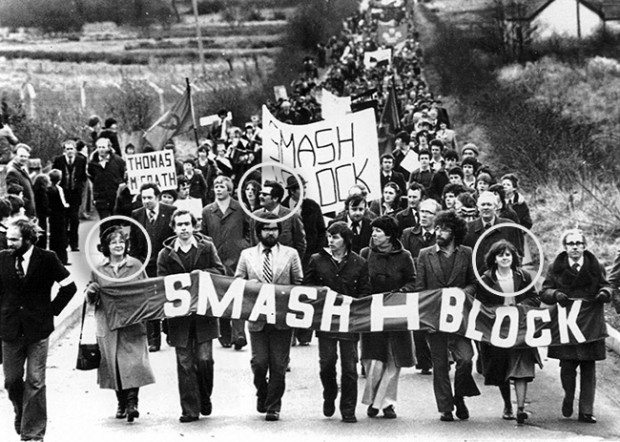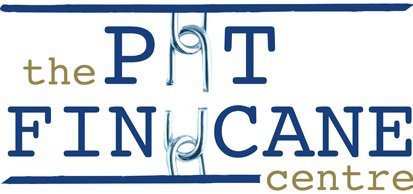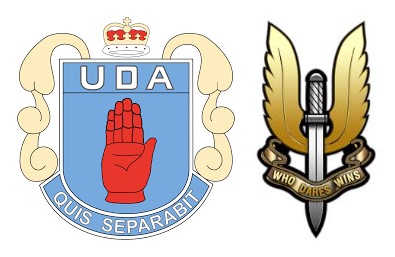3 February 2016
UDA murderer was in the Ulster Defence Regiment, Ministry of Defence admits – 35 years later

● County Tyrone, February 1980. Those heading the march included John Turnley (second row, with dark glasses) and Miriam Daly (far left, holding the banner), both subsequently assassinated by unionists, and Bernadette McAliskey (far right, holding banner)
MYSTERY surrounds why information was withheld from the courts for 35 years that a member of an Ulster Defence Association death squad that murdered a prominent Protestant anti-H-Blocks activist in 1980 was also a member of the British Army's Ulster Defence Regiment until shortly before the killing.
One of those convicted of the murder had told police that he was working with the SAS and it was the SAS who had targeted National H-Blocks Committee member John Turnley.
Families of the victims have said that at no time until very recently were they told of the killer's background in the British Army, a key factor given the strong suspicion of collusion with even direction by British Military Intelligence and/or the SAS.
William McClelland (now deceased) was part of a three-man UDA gang convicted of the murder of Rodney McCormick and former SDLP member John Turnley (44).
Turnley was a one-time British Army officer from a unionist background who had left the SDLP to help form the Irish Independence Party and become a high-profile campaigner in the National H-Blocks Committee against the withdrawal of political status from republican prisoners.
He was a councillor and one of a number of high-profile figures in the National H-Blocks Committee who were not members of Sinn Féin. Noel Lyttle, Ronnie Bunting and Miriam Daly were shot dead and Bernadette McAliskey was seriously wounded in another assassination attempt.
In a statement, Rodney McCormick’s son, Rory, said:
“At no stage following the arrest, prosecution or conviction of these three individuals was the family told that one of the suspects had been a member of the UDR from mid-1975 until late 1978.
“This was withheld from us, along with the Turnley family, the press and the public. Was the judge even aware?
“I was always of the view that our father was killed because of the failure to properly investigate the murder of John Turnley two months beforehand.
“These three individuals were arrested in suspicious circumstances just over an hour after the murder of John Turnley but were released within a short time.
“The circumstances of their brief arrest and release are deeply disturbing. A witness had identified suspects setting fire to a car and driving away in a blue van. This is the vehicle they were stopped in.
“According to the HET there is no ‘record to show whether the police swabbed [their] hands or clothing for gunshot residue’.
“It appears that no attempt was made either to confirm their alibis. A key witness who reported the getaway vehicle being set on fire and who gave a statement to the RUC was not asked to attend an identity parade. The HET described this as a ‘missed opportunity’.
A member of the RUC admitted knowing at least one of those detained.
“It is a matter of grave concern to be told that one of the killers was a member of the UDR until shortly before the murders.
“According to the HET report, McClelland told detectives (following his arrest in September 1980) that he had been a member of the UDA since 1973. This was mentioned in court.
“Were the RUC so incompetent that they were unaware of his UDR background?”

Speaking for the Pat Finucane Centre, Paul O’Connor said:
“The McCormick family provided us with a large bundle of papers related to the prosecution of these individuals. We attended numerous meetings with the HET and did our own research.
“Nowhere in the documents is there any mention of the UDR.
“When we wrote to the PSNI in July 2015 and enquired about possible UDR membership we were informed by the PSNI that: “There is no information held by Legacy Investigation Branch to indicate that Mr McClelland was a member of the armed forces, UDR or the Prison Service.
“Last week, following months of repeated enquiries with the Ministry of Defence in London, we received official confirmation that McClelland had been in the regiment.”
Paul O’Connor said that a number of questions must be asked.
● Was the Prosecution Service aware of this and if so why was it withheld from the court?
● Why was the PSNI unaware of this?
● Why were these murders described by the prosecuting counsel as ‘UFF’ attacks when the interview notes with those who were convicted make repeated mention of UDA not UFF involvement?
The Pat Finucane Centre spokesperson added:
“The headline in The Irish News reporting the conviction of these men on 11 March 1982 read: “‘Ban the UDA’ Demands Renewed”. “The Irish Independence Party, SDLP and Alliance all called for the UDA to be banned yet it was to be another 10 years before it was finally proscribed. We now know that from the available papers that it was the UDA leadership in Belfast who ordered the murders and supplied the guns. It is a mystery how admission in police interviews of UDA involvement mutated into prosecution claims that the mythical UFF was responsible.
“Following his guilty verdict, another of the accused, Robert McConnell claimed he was working for the SAS who, he claimed, had proposed John Turnley as a target.
“He went on to make a number of allegations of SAS involvement in targeting members of the National H Blocks Committee in which Mr Turnley was active.”
◼︎ In another twist, a Detective Chief Inspector told the court that information had been provided by Eric McConnell that was so “sensitive” that he told a detective to destroy the notes of the interview and rewrite them (East Antrim Times, 19 March 1982).

Follow us on Facebook
An Phoblacht on Twitter
Uncomfortable Conversations

An initiative for dialogue
for reconciliation
— — — — — — —
Contributions from key figures in the churches, academia and wider civic society as well as senior republican figures





